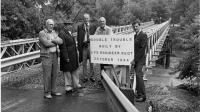By Larry Noonan, Reprinted from InsideToronto.com
The night of Oct. 15, 1954, during Hurricane Hazel, saw 21.6 centimetres of rain pelt the Toronto area. With many bridges washed out, transportation between points east of the Rouge Valley and Toronto became very difficult. Key bridges had to be rebuilt quickly. One such bridge was the one on Old Finch Avenue north of the Toronto Zoo east of Sewell’s Road.
Sir Donald Bailey designed a portable, pre-fabricated, truss bridge prior to the Second World War. This Bailey Bridge was used as a quickly assembled assault bridge. After the war, the Ontario government became the largest holder of Bailey Bridges in the world, and General Dwight Eisenhower listed the Bailey Bridge as one of the three pieces of equipment that most contributed to victory in Europe.
On Oct. 17, the lieutenant governor called out Toronto area militia units to help with the clean up. On Oct. 19, lieutenants Gord MacKendrick and Mid Kitchen were sent to the Finch bridge site to evaluate the situation. The bridge was gone but the north abutment was still standing.
The south abutment was undermined and collapsed in several pieces down the river bank. Construction was started on Oct. 20. A steam pile driver was borrowed from the general contractor A.E. Rule Ltd. and moved to the site by Ontario Hydro on a low loader truck.
The pile driver needed an operator as well as a fireman to stoke the boiler. Kitchen, with a work force from the 2nd Field Engineer Regiment of the Canada Military engineers, worked through the night under floodlights to complete the pile placements. The construction of the trestle superstructure was completed on Oct. 22 with the crane lifting the heavy top timbers into place. The Bailey spans were lifted by the crane into place that evening. Traffic was flowing across the river on a 190-foot Bailey Bridge by noon on Oct. 24.
In 1984, the 2nd Field Engineer Regiment was granted the Freedom of Metropolitan Toronto in recognition of its work in restoring bridges in southern Ontario in 1954, and a small ceremony was held on the bridge site at that time.
Larry Noonan is a retired teacher and school principal in Scarborough. Interested in history, he is working on stories of the Rouge valley in preparation for the new Rouge National Urban Park. His collection of stories is called “People’s Stories for a People’s Park”. Twitter @RNUP_NOW. Visit www.rougenationalnow.com for Friends of Rouge National Urban Park. Contact him at larrynoonan@rogers.com
